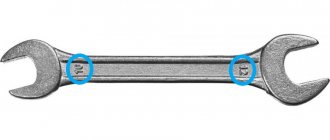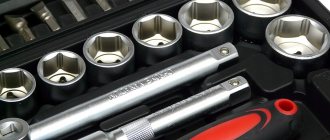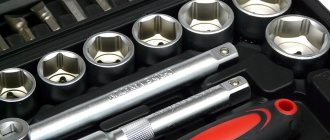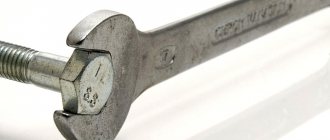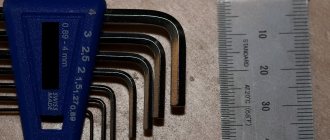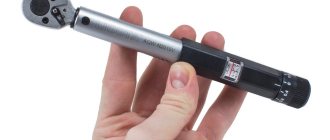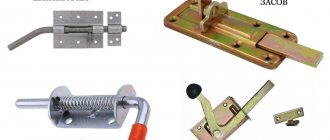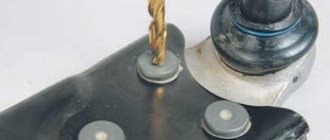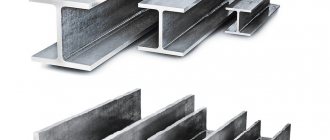The work of assembling and disassembling mechanisms and assemblies involves unscrewing nuts. Some of them are in places where a regular open-end wrench cannot reach. A socket wrench is available for unscrewing such hard-to-reach nuts.
Open-end wrenches
When people talk about a wrench, the first thing that comes to mind is the open-end wrench. The nut is fixed with jaws that resemble horns, hence the name. But according to GOST it is called an open-ended wrench. The longitudinal axis of the handle is located at an angle of 15° to the axis of the head. It is specially designed to work freely in confined spaces. There are keys with an angle between the head and the handle of 70° . In combined versions, the angle is 15° at one end and 70° at the other.
Often open-end ones have two heads, at the ends of the handle, for different sizes of nuts. This significantly reduces the number of tools needed in the kit. Carobs have become widespread because of their versatility, ease of use, and this despite the shortcomings. The main one is that the contact area is small and with strong pressure the corners of the nut are crushed, and if the tool is larger than the required size, then this often happens. If the correct size is used, the impact force will be greater. The thinner the jaws on the key, the higher the likelihood of damaging the corners .
An impact wrench is used to unscrew rusty bolts and nuts; at the other end it has thickenings where blows are applied with a sledgehammer or hammer.
Manufacturers often produce keys with their own lip profile. IBEX instruments have one horn that is shortened, with a short protrusion, and the other has a convex recess of a modified shape. This modification has two obvious advantages:
- Fast operation - easy to remove and rearrange with a simple pull.
- The contact spots are located at a greater distance from the corners of the nut, which reduces the chance of lubricating the edges.
In simpler modifications, corrugation or convexity is applied . This helps to work with bolts and nuts with crumpled edges.
Kinds
There are a lot of types of wrenches, but not all of them are widely used in everyday life. A significant part of the varieties of such tools is used in special industries or in a professional environment. Therefore, we will describe only the main varieties of this tool.
Carob
The most common type of wrench. They got their name because their ends actually resemble animal horns. The open-end wrench has an open U-shaped mouth, its working profile covers the part from 2 or 3 sides.
The distance between the jaws at the two ends is different, which allows you to use one tool when working with nuts of different sizes. For better transmission of torque and increased range of use in hard-to-reach places, the axes of the open-end wrench heads are deviated by 15 °C relative to the longitudinal axis of the handle.
Carob one-sided
Single-sided open-end wrenches are quite rare in everyday life - they are usually used in production. To increase the torque, a pipe can be placed on the free end of the tool. Typically, such a tool has a large size between the jaws - from 36 to 65 mm.
Cap (ring)
Spanners have a working profile in the form of a closed ring with 6 or 12 edges.
Thanks to this design, a large contact area is achieved - the profile completely fits the working surface of the part, so it does not come off its edges. Typically, ring wrenches are double-sided with rings of different sizes within close ranges. A tool of this design is more convenient to use than an open-end wrench, since it can be rotated without lifting it from the part, without moving the jaw or intercepting the handle. Due to their smaller size, they are more convenient to store and transport.
The main disadvantage of the classic double-sided socket wrench is the difficulty of working in hard-to-reach places, since rotation requires free space.
In addition to double-sided ring wrenches, the following types of tools are available:
- Single-ended - a tube can be placed on the other end to increase torque.
- Curved - allow you to work in places with limited space.
- Impact sockets - allow you to tighten a part more strongly or, conversely, unscrew a rusty nut (much thicker than usual).
- With ratchet - also used when working in hard-to-reach places.
Combined
Combination wrenches are a design with two different ends: one open-end type and the other ring type. The working profiles of such a tool are used in various conditions, when it is convenient - a ring, in conditions of limited space - a horn jaw. Combination wrenches are always made with ends of the same size, for example, 13*13, 15*15, etc. There are varieties of combination wrenches with other tips, for example, open end and socket, but they are less common than the classic version.
End
Socket wrenches are used in specific conditions, most often in recesses when the nut is deeply recessed relative to the surface, which does not allow the use of conventional open-end or ring tools.
They are a tube whose inner surface of the edges has a hexagonal shape. There are two types:
- Direct
To impart torque, a perpendicularly located lever is used, inserted into the hole of the tool, for example, a screwdriver.
- Curved
They have an L-shape or T-shape, allowing rotation without the use of additional devices.
Expert opinion
Torsunov Pavel Maksimovich
Socket wrenches have a small torque, so they have received limited distribution. Quite often they are used when servicing cars; typical representatives of this type of tool are spark plugs, balloon wrenches, and cardan wrenches. The end tool can also be produced in various modifications: with a ratchet mechanism for easier access, in combined versions (cross barrels).
Adjustable
Adjustable wrenches are a modification of open-end wrenches that have variable dimensions due to changing the distance between the jaws of the ends. In Russia, keys of the Swedish type are most widespread; instruments of the American and French types are also widespread throughout the world.
The upper jaw of such a tool is usually fixed, the lower one is movable. The distance between them is adjusted via a worm gear. The tool is first applied to the part, after which the lower jaw is fixed in the desired position by rotating the worm gear.
Adjustable wrenches are universal - one tool can replace several open-end wrenches of similar dimensions. They also come in different sizes, the range of application is indicated on the handle of the tool. Another plus is the ability to work with nuts of non-standard sizes.
However, such keys are not without their drawbacks:
- Large head size, which affects ease of storage and transportation.
- A small amount of torque due to the presence of irremovable play between the jaws due to the mobility of the lower one.
It will not be possible to unscrew a tightly screwed nut with such a tool. Therefore, adjustable wrenches are usually used for low-intensity work and at home. Such a tool is poorly suited for professional work.
Pipe (gas)
A pipe wrench is considered one of the options for an adjustable wrench: it also has one fixed jaw and one movable jaw, adjustable using a screw gear. The main difference from the adjustable one is that the gas one has special notches on the inner surface of the jaws, which allow them to cover and hold the round surfaces of the pipes. It is also distinguished by the presence of a screw type transmission rather than a worm type.
In everyday life, pipe wrenches are often called plumbing or gas wrenches, since they are most often used to work with plumbing or gas pipes. Primarily, a tool of this type is intended for fixing and rotating pipes, however, due to its versatility, it can still be used when working with parts of any shape.
Expert opinion
Torsunov Pavel Maksimovich
Pipe wrenches do not require a hex nut profile and are capable of working with rounded parts. The torque of pipe wrenches is less than that of box wrenches. Another disadvantage of the tool is the possibility of damage to the working surface of the part due to the high pressure of the jaws on the metal. In general, gas wrenches are a rather crude tool, not intended for fine work.
Hexagons
The hexagonal (inbus) key is male, that is, in order to rotate it, it is placed in the slot of the part.
Hexagons are a steel rod that is L-shaped to facilitate rotation. The working profile is a head in the shape of a regular hexagon. Typically, hexagons are used when assembling/disassembling furniture; their head fits the slot of a confirmat (furniture self-tapping screw with a blunt end), which is used to connect wood parts (chipboard, MDF, solid wood, etc.). Hex sockets range in size from 1.5 to 24 mm and are usually sold in sets.
Star (Torx)
A variation of a male wrench with an asterisk (Torx) end. A popular format abroad, which has become widespread in Russia. The only difference from other male wrenches is the shape of the head, which is a six-pointed star (Torx format).
Typically, Torx is used in the repair of household appliances, mobile phones, and cars. They are marked with the index T with a number indicating the dimension. The smallest sizes (T5, T6) are found exclusively in cell phone repair kits. The maximum size is T50, which is equal to 8.83 mm.
Special
Non-sparking wrench.
Special wrenches have design and/or application features that sharply distinguish them from the main array of tools for tightening threaded connections. They are usually used in special types of production or for maintenance and repair of certain types of equipment.
In particular, special keys include:
- Intrinsically safe - made of steel with the addition of an alloying additive (aluminum or beryllium), used in industries with explosive atmospheres and does not produce a spark when dropped and in contact with metal.
- Ear-shaped - used for working with non-standard shaped bolts.
- Carriage type - designed for loosening round carriage-type nuts (with slots in the end part or holes).
- Extractors are tools for unscrewing damaged parts (nuts with worn edges, bolts with torn heads, etc.).
The familiar bicycle “family tools” are also special - tools with a combination of hexagonal holes and two carriage recesses.
Spanners
A ring wrench, a more advanced type of open-end wrench.
It was made to solve the main drawback - the minimum contact patch. The head rests on the entire area of the nut and the load is evenly distributed over the entire surface. On all six sides, instead of two. And the fact that the contact patch is located far from the corners almost eliminates their crushing in the process. The size of the cap head is smaller than that of the carob head and it is much more convenient for them to work. The spanner wrench profile comes with 12 edges (the most popular option) or 6 (TORX). The advantages of a twelve-sided tool are ease of use; 30° is enough to turn, when TORX requires twice as much. But the second, thanks to the design of the edges, has a larger contact area, which makes it possible to apply more force without fear of blurring the corners.
The ring on the tool can be at the same level as the handle, or at an angle of 15° (with the head bent). A certain position of the ring (sometimes the only correct one) is suitable for different conditions. Flat keys are almost never used. The most common type is with a bent head. The tool has a ratcheting mechanism and is often equipped with a swivel head.
Slip-on, like hinged, are equipped with two rings of different sizes . Percussion modifications are also available, as in horn versions. For cases in which it is impossible to place the tool on top, use a variation with an open ring. This is common when servicing pneumatic and hydraulic installations.
For ease of work in hard-to-reach places, on some models, the handles have a curved shape, and the motor key is shaped like a crescent.
Question 5.3.3. Keys
KTN key. The pipe is clamped with a wrench in three places with a die, a cracker and jaw 2.
The die and the cracker have notches that are pressed into the pipe to prevent the key from sliding along it.
The block 8
is kept
which is screwed
To prevent the wrench placed on the pipe from slipping, there is a spring. Die 7 is kept from sliding in the groove by the end of handle 1,
which fits into the hole in the die.
To remove the key from the pipe, you should grab handle 1 with your left hand,
and handle 6 with your right hand, turn it and remove the key from the pipe. High-torque wrenches are used to operate automatic machines for making and unscrewing tubing pipes.
Rice. 5.17. Pipe wrench Khalilov KTN:
1 —
pen; 2 - jaw; 3 - spring; 4 — hinge pin; 5.9 - locking bolts;
6 —
lever; 7 - die; 8 – cracker
The most worn parts of these keys are dies and crackers; When triggered, they must be replaced.
To ensure normal and safe operation of the key, it is necessary to periodically clean the notch of the cracks and dies with a metal brush, as well as check the springs and, if necessary, adjust their tension.
KTND wrenches (Fig. 5.18) are intended for screwing and unscrewing tubing pipes, as well as couplings for rods, polished rods when repairing well pumps.
-265-
The key consists of two main parts: jaw 5 and handle 1,
hingedly connected.
The key is held on the pipe by a spring 6,
attached with one end to the jaw and the other to the hinge pin.
The spring tension is adjusted by rotating the finger. When tensioned, the spring is secured to the screw pin 7. For ease of use with a key, there is a handle on the jaw 4,
which simultaneously serves as a limiter for the movement of die
3.
In this wrench, a round die 2 with teeth on the outer surface is installed on the axis of the handle. To protect the die from turning, there is a lock that is attached to the handle with a bolt.
Rice. 5.18. Pipe wrench KTND:
1 - handle; 2 - round die; 3 - flat die; 4 - handle; 5 —
jaw;
6 - spring; 7 – screw
CAT keys. To replace the KTND pipe wrenches, single-hinged wrenches of the KOT type have been developed, in which the fastening of the jaw with the handle is strengthened, the round die is replaced by a segmented one, and the fixation of the spring is improved, preventing its breakage. While reducing weight, due to improved design of the jaw and handle, the transmitted torque is increased.
KTG keys (Fig. 5.19) designed by G.V. Molchanov are used when working with an APR automatic machine. The key consists of a handle and a door hinged to the jaw. When the key is applied to the pipe, the flap rotates around the finger, ensuring that the key is inserted, and then is pressed tightly against the pipe. When you turn the key by the handle, the handle creates a force that presses the sash against the pipe.
This ensures the transmission of torque to the unscrewed (or screwed) pipe
-266-
- M keys are used for mechanized screwing and unscrewing of pipes using an APR-2VB automatic machine and mechanical keys KMU. Unlike the KTG key, it has an additional cracker 1
on the jaw 6, which increases the reliability of the key.
The key consists (Fig. 5.20) of a handle 5
and a flap
3,
pivotally connected to the jaw
6
using pin
2.
When the key is put on the pipe, the flap
3
rotates around pin
2
and under the action of a spring
4
pressed tightly with breadcrumbs
1
to the pipe. Unlike KTGU, the KTGU-M key has fastenings on the axles with spring rings that prevent the axes from unscrewing and falling out. The reliability and durability of crackers has been increased due to the use of steel grade 12ХНЗА, instead of St 20.
KTD keys. Double-joint pipe wrenches are manufactured in two versions - KTD and KTD U.
The KTD type wrench is used for screwing and unscrewing pump-compressor pipes manually, and the KTDDU type with a shortened handle is used for working with mechanisms.
The key (Fig. 5.21) consists of a large 2
and small
1
jaws, small
6
and large
3 handles,
hingedly connected to each other.
4
is mounted on the hinge axis of the large jaw and the handle tightening the jaws to the center of the forming arcs, due to which the key is held on the pipe.
There is a self-aligning crack on the small jaw
5 with an arched toothed surface, thanks to which the cracker of the entire surface is in contact with the pipe. This provides more reliable gripping of the pipe, reduces the pressure on the contact surface, which protects the crackers and the surface of the pipes from damage.
Keys KTM and KSM (Fig. 5.22) designed by G.V. Molchanov are used when working with the APR automatic machine. Key parts
-267-
KTM - jaw, sash, latch, cracker. The jaw and valve are connected by a hinge. The jaw is equipped with a latch that interacts when closed with a special spike located on the sash.
The jaw of the key has an eccentric bore along which the cracker moves. When the key operates, the machine carrier transmits force to a roller mounted at the end of the jaw. Under the influence of friction forces, the cracker moves relative to the jaw, ensuring the pipe is captured.
Rice. 5.22. Pipe and lock wrenches:
A -
pipe KTM, 1
—
flap;
2 — cracker latch; 3 - cracker; 4 - jaw; 5 - roller; b —
locking KSM, 1 — sash; 2 - latch; 3 - jaw; 4 — reversible stop;
5 – cracker
The KSM key has a similar design, but is equipped with a reversible stop, and its jaw shape is different.
The locking wrench is used to lock tubing strings during their mechanized screwing and unscrewing.
When moving from unscrewing pipes to making up, the stop is rearranged. During operation, the working surfaces of the wrench are adjacent to the pipe coupling and grip it, preventing slipping.
Reliable operation of the key is ensured by a spiral bore on the inner surface of the jaw, which serves to jam the cracker between the coupling and the jaw.
-168-
The chain key (Fig. 5.23) consists of two jaws 2
with teeth, chain
3 with
flat hinge links and handle
1.
4
and nut
5
passing through the middle of the cheeks. One end of the chain is attached to the handle using pin
6
and the initial link 7. Pin b fits into the corresponding holes in the cheeks .
The cheeks are thermally treated. When installing the wrench on the pipe 8
, the jaw teeth tightly cover the pipe and serve as a support for the handle. By pressing the handle, you can screw or unscrew the pipe. The cheeks have four working sectors. When the teeth wear out, the cheeks are turned and the teeth of the unworn sector are put into operation.
The advantages of a chain wrench are its simplicity of design and the ability to work with pipes of different diameters with one wrench.
The chain wrench is reliable in operation; installed on a vertical pipe, it does not fall. This is convenient when making up and unscrewing pipes during repair work on wells. During the process of screwing and unscrewing pipes, the operator and assistant operator alternately push the handle of the wrench, and it continues to rotate by inertia. This way the key is passed from hand to hand.
The disadvantages of a chain wrench include its large mass, the inconvenience of loading the wrench on a pipe and the difficulty of freeing the pipe when it is jammed in the jaws of the wrench, as well as abrasion and crushing of the pipe surface, which shortens its service life.
In addition, slippage and chain breaks are often observed.
The pipe wrench must have intact, unbroken chain links and teeth on the jaws.
Rice. 5.23. Chain key
-269-
It is prohibited to use pipe wrenches using spacers between the chain and the pipe. During operation, the teeth on the jaws should be cleaned of dirt. It must be borne in mind that when working with a chain wrench, accidents can occur: when the key falls out of the worker’s hands due to contamination of the teeth or their breakage; when the chain breaks; failure of the key due to the alignment of the notches on the cheeks of the key and failure of the chain due to the alignment of the stops located between the cheeks of the key.
Rod keys. Screwing and unscrewing of pump rods and couplings during well repair is carried out using rod wrenches, manufactured for carrying out work manually and with automatic machines.
KSh key (Fig. 5.24, a)
designed for manual work.
The KShK circular rod wrench (Fig. 5.24, 6) with adjustable clamping rams is used for unscrewing rods with the borehole pump plunger attached. During underground repairs of wells, when the plunger of a well pump becomes stuck, it is necessary to lift the pipes along with the rods.
The coupling connections of the pipes do not match the connections of the rods.
Therefore, after unscrewing the next pipe, there will be a smooth rod body above the coupling installed on the elevator, which cannot be grasped with a rod wrench. Unscrewing the rods with a chain wrench is dangerous, since due to the springing action of the rod, the key can be pulled out of your hands and cause injury.
Rice. 5.24. Rod wrenches:
A -
KS;
6 —
circular KShK;
c —
KShSh 16...25; 1 - head; 2 - handle
-270-
In a circular wrench, the rods are grabbed with dies that have angular cutouts with teeth. One of the dies, fixed, is secured by two pins on the inside of the key, and the second, movable, is attached to the inner end of the clamping rod.
To replace the rod wrench KSh, a hinged rod wrench KShSh 16...25 has been developed, which replaces the KSh wrench of three standard sizes.
The key KShSh 16…25 (Fig. 5.24, c) consists of a handle 2
and a hinged head
1,
pressed by a spring to the head of the handle.
KTN key. The pipe is clamped with a wrench in three places with a die, a cracker and jaw 2.
The die and the cracker have notches that are pressed into the pipe to prevent the key from sliding along it.
The block 8
is kept
which is screwed
To prevent the wrench placed on the pipe from slipping, there is a spring. Die 7 is kept from sliding in the groove by the end of handle 1,
which fits into the hole in the die.
To remove the key from the pipe, you should grab handle 1 with your left hand,
and handle 6 with your right hand, turn it and remove the key from the pipe. High-torque wrenches are used to operate automatic machines for making and unscrewing tubing pipes.
Rice. 5.17. Pipe wrench Khalilov KTN:
1 —
pen; 2 - jaw; 3 - spring; 4 — hinge pin; 5.9 - locking bolts;
6 —
lever; 7 - die; 8 – cracker
The most worn parts of these keys are dies and crackers; When triggered, they must be replaced.
To ensure normal and safe operation of the key, it is necessary to periodically clean the notch of the cracks and dies with a metal brush, as well as check the springs and, if necessary, adjust their tension.
KTND wrenches (Fig. 5.18) are intended for screwing and unscrewing tubing pipes, as well as couplings for rods, polished rods when repairing well pumps.
-265-
The key consists of two main parts: jaw 5 and handle 1,
hingedly connected.
The key is held on the pipe by a spring 6,
attached with one end to the jaw and the other to the hinge pin.
The spring tension is adjusted by rotating the finger. When tensioned, the spring is secured to the screw pin 7. For ease of use with a key, there is a handle on the jaw 4,
which simultaneously serves as a limiter for the movement of die
3.
In this wrench, a round die 2 with teeth on the outer surface is installed on the axis of the handle. To protect the die from turning, there is a lock that is attached to the handle with a bolt.
Rice. 5.18. Pipe wrench KTND:
1 - handle; 2 - round die; 3 - flat die; 4 - handle; 5 —
jaw;
6 - spring; 7 – screw
CAT keys. To replace the KTND pipe wrenches, single-hinged wrenches of the KOT type have been developed, in which the fastening of the jaw with the handle is strengthened, the round die is replaced by a segmented one, and the fixation of the spring is improved, preventing its breakage. While reducing weight, due to improved design of the jaw and handle, the transmitted torque is increased.
KTG keys (Fig. 5.19) designed by G.V. Molchanov are used when working with an APR automatic machine. The key consists of a handle and a door hinged to the jaw. When the key is applied to the pipe, the flap rotates around the finger, ensuring that the key is inserted, and then is pressed tightly against the pipe. When you turn the key by the handle, the handle creates a force that presses the sash against the pipe.
This ensures the transmission of torque to the unscrewed (or screwed) pipe
-266-
- M keys are used for mechanized screwing and unscrewing of pipes using an APR-2VB automatic machine and mechanical keys KMU. Unlike the KTG key, it has an additional cracker 1
on the jaw 6, which increases the reliability of the key.
The key consists (Fig. 5.20) of a handle 5
and a flap
3,
pivotally connected to the jaw
6
using pin
2.
When the key is put on the pipe, the flap
3
rotates around pin
2
and under the action of a spring
4
pressed tightly with breadcrumbs
1
to the pipe. Unlike KTGU, the KTGU-M key has fastenings on the axles with spring rings that prevent the axes from unscrewing and falling out. The reliability and durability of crackers has been increased due to the use of steel grade 12ХНЗА, instead of St 20.
KTD keys. Double-joint pipe wrenches are manufactured in two versions - KTD and KTD U.
The KTD type wrench is used for screwing and unscrewing pump-compressor pipes manually, and the KTDDU type with a shortened handle is used for working with mechanisms.
The key (Fig. 5.21) consists of a large 2
and small
1
jaws, small
6
and large
3 handles,
hingedly connected to each other.
4
is mounted on the hinge axis of the large jaw and the handle tightening the jaws to the center of the forming arcs, due to which the key is held on the pipe.
There is a self-aligning crack on the small jaw
5 with an arched toothed surface, thanks to which the cracker of the entire surface is in contact with the pipe. This provides more reliable gripping of the pipe, reduces the pressure on the contact surface, which protects the crackers and the surface of the pipes from damage.
Keys KTM and KSM (Fig. 5.22) designed by G.V. Molchanov are used when working with the APR automatic machine. Key parts
-267-
KTM - jaw, sash, latch, cracker. The jaw and valve are connected by a hinge. The jaw is equipped with a latch that interacts when closed with a special spike located on the sash.
The jaw of the key has an eccentric bore along which the cracker moves. When the key operates, the machine carrier transmits force to a roller mounted at the end of the jaw. Under the influence of friction forces, the cracker moves relative to the jaw, ensuring the pipe is captured.
Rice. 5.22. Pipe and lock wrenches:
A -
pipe KTM, 1
—
flap;
2 — cracker latch; 3 - cracker; 4 - jaw; 5 - roller; b —
locking KSM, 1 — sash; 2 - latch; 3 - jaw; 4 — reversible stop;
5 – cracker
The KSM key has a similar design, but is equipped with a reversible stop, and its jaw shape is different.
The locking wrench is used to lock tubing strings during their mechanized screwing and unscrewing.
When moving from unscrewing pipes to making up, the stop is rearranged. During operation, the working surfaces of the wrench are adjacent to the pipe coupling and grip it, preventing slipping.
Reliable operation of the key is ensured by a spiral bore on the inner surface of the jaw, which serves to jam the cracker between the coupling and the jaw.
-168-
The chain key (Fig. 5.23) consists of two jaws 2
with teeth, chain
3 with
flat hinge links and handle
1.
4
and nut
5
passing through the middle of the cheeks. One end of the chain is attached to the handle using pin
6
and the initial link 7. Pin b fits into the corresponding holes in the cheeks .
The cheeks are thermally treated. When installing the wrench on the pipe 8
, the jaw teeth tightly cover the pipe and serve as a support for the handle. By pressing the handle, you can screw or unscrew the pipe. The cheeks have four working sectors. When the teeth wear out, the cheeks are turned and the teeth of the unworn sector are put into operation.
The advantages of a chain wrench are its simplicity of design and the ability to work with pipes of different diameters with one wrench.
The chain wrench is reliable in operation; installed on a vertical pipe, it does not fall. This is convenient when making up and unscrewing pipes during repair work on wells. During the process of screwing and unscrewing pipes, the operator and assistant operator alternately push the handle of the wrench, and it continues to rotate by inertia. This way the key is passed from hand to hand.
The disadvantages of a chain wrench include its large mass, the inconvenience of loading the wrench on a pipe and the difficulty of freeing the pipe when it is jammed in the jaws of the wrench, as well as abrasion and crushing of the pipe surface, which shortens its service life.
In addition, slippage and chain breaks are often observed.
The pipe wrench must have intact, unbroken chain links and teeth on the jaws.
Rice. 5.23. Chain key
-269-
It is prohibited to use pipe wrenches using spacers between the chain and the pipe. During operation, the teeth on the jaws should be cleaned of dirt. It must be borne in mind that when working with a chain wrench, accidents can occur: when the key falls out of the worker’s hands due to contamination of the teeth or their breakage; when the chain breaks; failure of the key due to the alignment of the notches on the cheeks of the key and failure of the chain due to the alignment of the stops located between the cheeks of the key.
Rod keys. Screwing and unscrewing of pump rods and couplings during well repair is carried out using rod wrenches, manufactured for carrying out work manually and with automatic machines.
KSh key (Fig. 5.24, a)
designed for manual work.
The KShK circular rod wrench (Fig. 5.24, 6) with adjustable clamping rams is used for unscrewing rods with the borehole pump plunger attached. During underground repairs of wells, when the plunger of a well pump becomes stuck, it is necessary to lift the pipes along with the rods.
The coupling connections of the pipes do not match the connections of the rods.
Therefore, after unscrewing the next pipe, there will be a smooth rod body above the coupling installed on the elevator, which cannot be grasped with a rod wrench. Unscrewing the rods with a chain wrench is dangerous, since due to the springing action of the rod, the key can be pulled out of your hands and cause injury.
Rice. 5.24. Rod wrenches:
A -
KS;
6 —
circular KShK;
c —
KShSh 16...25; 1 - head; 2 - handle
-270-
In a circular wrench, the rods are grabbed with dies that have angular cutouts with teeth. One of the dies, fixed, is secured by two pins on the inside of the key, and the second, movable, is attached to the inner end of the clamping rod.
To replace the rod wrench KSh, a hinged rod wrench KShSh 16...25 has been developed, which replaces the KSh wrench of three standard sizes.
The key KShSh 16…25 (Fig. 5.24, c) consists of a handle 2
and a hinged head
1,
pressed by a spring to the head of the handle.
Combination keys
The instruments combine a carob on one side and a cap on the other. They lack the disadvantages of both, while maintaining the advantages. This option is the most common and in demand. Companies are not limited to combining cap and horn tools. You can often find other options, for example, with an end cap. But if we talk about a combination wrench, without specifying which one, then it is a horn-socket wrench .
With modifications with the head rotated 90°, the palm places emphasis on the large plane of the head, and not on the small one.
Adjustable wrenches
An adjustable wrench is a regular open-end wrench, in which you can change the gap between the jaws. Most often they are used in everyday life, not in professional activities. Masters avoid them because of the following disadvantages:
- The large size of the head makes it difficult to work in hard-to-reach places.
- The play of the horns does not allow the nut to be tightly fixed, which, with little effort, leads to smoothing of the corners and breaking, and this can result in injury.
- It is impossible to generate significant torque due to low strength.
- It is necessary to constantly adjust the jaws while working.
This tool has only one advantage - the ability to stretch the jaws to the desired size. This tool is easily replaced with a socket tool, with replaceable heads.
Symbolic Key Values
Among the thousands of household items that serve people faithfully, keys not only have practical applications, but also carry a special symbolic meaning. It is not only the key itself that is valuable, but also its unique function - the right to open and close the door. The key is able to remove a material or spiritual obstacle in our path, and symbolizes power, access to entry and exit, freedom and access to values, treasures, and knowledge. We find the generally accepted symbolism of the key and its meaning for the owner of the key in cultures all over the world.
The word key , like the key to a house is reconstructed not only for Proto-Slavic *kľučь (see ESSYA, issue 10, pp. 50-52), but also - dialectally - for Proto-Indo-European, cf. *klēu̯is based on Lat. clavis and Greek κληΐς with the meaning “key” , although we could only talk about a very primitive key, which was akin to a stick and the shape of which can be restored better than any reconstructions using the expression: cranes fly like a key. (Linguistic research. O.N. Trubachev. Ethnogenesis and culture of the ancient Slavs.)
KEY
-
KEY
, from Sanskrit: the root
kunc - “ring, make crooked”, kuncika - chain mail made of rings. The British Dictionary notes: the word KEY is
of unknown origin, abnormal evolution and no known relatives.
Lieberman writes: “The original meaning of *kaig-jo - ( CLAW ) appears to have been “*a pin with a curled end.” Words with the root * kai- followed by a consonant meaning “twisted, bent” are common only in North Germanic languages CLUE - KEY
, from Old German.
clewe , cleue - KLUKA, HOOK .
In many religions, the key is seen as a symbol of the transition from the earthly world to the other world or to another state of being. The keys were held in the hands of the ancient Roman two-faced god of doors, Janus, who opens the entrance to the future and closes the door to the past.
The divine gatekeeper Janus opened the doors to a new day, and closed the darkness of the night, and opened the transitions from one season to another.
The gods of Ancient Egypt wore the sign of an ankh - a special type of cross with a large ear, which played the role of a key and symbolized the transition to the afterlife.
In Christianity, keys are a symbol of power and authority, giving the power to forgive sins and excommunicate. Iconography traditionally depicts Saint Peter holding two keys, gold and silver, to the gates of Heaven and Hell.
About 700 treasures from the 10th century have been found on the rich island of Gottand. In the vicinity and territory of Visby (Swedish Visby), the main city of the Swedish island of Gotland , which later became an important center of the Hanseatic League , traces of the activities of trading communities of the Viking Age , representing the initial stage of development of this medieval center. Together with numerous finds within the city walls of Visby, archaeological sites indicate trade as a main activity already in the Viking Age. Trade of the 10th century required reliable storage of goods - turnkey.
Since 1059, the conclave (Italian cum clavi - “under the key”) , a college of cardinals began to play an important role in the Catholic Church . Until the 11th century, elections for the Pope sometimes dragged on for several years, as church hierarchs fought fiercely among themselves for the title of Great Pontiff , which gave its holder almost unlimited power over all Catholic Christians. The squabbles of cardinals and archbishops, which sometimes reached the point of armed clashes, greatly undermined the authority of the “holy Catholic Church,” so Pope Nicholas II (1059-1061) introduced a new election procedure, called the conclave.
The reform of Nicholas II turned out to be extremely effective, since the college of cardinal electors began to be locked in a conclave (Italian cum clavi - “under the key”) in the hall and kept them locked there until they proclaimed the name of the newly elected pope. Hungry and exhausted by the stuffiness, the cardinals came to an agreement much more quickly than before.
The main emblem of the papal power of the Roman Catholic Church is the diagonally crossed gold and silver keys, the same ones that were handed over by Christ to the Holy Apostle Peter. The Pope is considered St. Peter's vicar on earth. The coat of arms of the Papal State of Vatican City depicts the keys of the Apostle Peter, crowned with the papal tiara. Two crossed keys can also be seen in the coat of arms of Pope Nicholas V (1447-1455).
In the Byzantine Orthodox Church, the ecclesiarch (cleric) was in charge of all precious church utensils.
A bunch of keys in the hands of a warrior is an attribute of Saint Hippolytus, who was the jailer of Saint Lawrence.
In the Apocalypse, an angel, armed with the keys to hell (“the abyss”) , bound a monstrous dragon (“the Ancient Serpent”) and cast him into the hellish abyss for a thousand years.
In the fine art of the Renaissance, Saint Martha of Bethany, sister of Mary and Lazarus, who became the collective image of a zealous housewife, is endowed with a bunch of keys. Saint Martha was concerned about a great meal when she “received the Lord into her house.”
A large number of decorative keys from the Viking Age (800-1066 AD) have been discovered in women's graves. Bronze keys, made with superb craftsmanship, were used as a status symbol by women and were often true works of art, worn by the lady of the house in a belt around her waist.
The Old Scandinavian key was found in the Heggum (Heggeymar) mound, measuring 9.5 centimeters in length and decorated with intertwined figures of animals in the “Scythian animal style”; perhaps the key served as a home talisman, like the “serpentine”, talisman of Prince Vladimir Monomakh. After getting married, the new mistress of the house received the keys to doors and treasure chests, as a visible sign of her new status, position in the house and power. Bronze key to the Heggum farm in Røyken in the Oslofjord.
A silver figure of a woman, possibly the goddess Freya (Preya), was found at Lake Tisso, Denmark.
The key as an attribute belonged to the Phrygian Great Mother, the goddess Cybele (Sibyl, Siberia), and the allegorical figure of Fidelity.
In the Middle Ages, the key was quite widely represented as a symbol of knowledge of all the secrets of existence. The key was the emblem of European communes (free cities). The delegation of the medieval city, surrendering to the mercy of the winner, solemnly presented the keys to the city gates to the invader on a velvet pillow. This custom made the key a sign of submission and surrender.
The key emblem is associated with a number of ecclesiastical and secular positions of high rank. The Grand Keykeeper of the Teutonic Order, who was in charge of its property, was a member of the order's chapter (high council). The gilded key, suspended from the back on a ribbon to the belt, originally constituted the distinctive emblem of the French court chamberlain. Subsequently, the position of chamberlain was introduced in other European states.
The key is in the Russian Empire.
Ancient chamberlain keys are unique antiques that were an important attribute of the court rank. Their name comes from the German word "Kammerherr". Such a key meant that the chamberlain had the right to enter all the personal apartments of his monarch. At a time when St. Petersburg was the capital of the Russian Empire, chamberlains received special symbolic keys during a special ceremony at court. Of course, the chamberlain’s keys did not fit into any door in the imperial residence.
Initially, the history of the chamberlain position began with real chamberlain keys, intended not for opening chambers, but for storeroom doors. In the sixteenth century, at the Spanish courts there was a position of camarero, the holder of which was in charge of the king’s treasury and carried the key to it. At the courts of European emperors and kings, “cameriers” or “camerarius” served, later renamed “chamberlains” and becoming “room nobles” who received symbolic keys.
Having lost their functionality, the chamberlain's keys became more elegant and were particularly beautiful. Ancient keys began to be made using gilding, and their heads were decorated with monograms and coats of arms of monarchs. The key keeper at the court of the Russian tsars was in charge of table supplies, drinks and servants. The rank of chamberlain in Russia appeared in 1711 after the official marriage of Peter the Great with Marta Skavronskaya. The reform of the court staff according to the European model led to the replacement of ordinary solicitors and key holders, room holders and stewards, with the position of chamberlain; the main symbol of his position was the chamberlain key at the court of Peter the Great.
Having ascended the Russian throne
in 1762, Empress Catherine II immediately determined the list of duties of the chamberlains and granted them the rank of conditional major general, obliged to stand at the throne and carry the train behind the empress. The chamberlains received not only a general's uniform, but also a golden key, which served as a sign of correcting the title of the position.
The chamberlains' keys could be different. Servants who managed to achieve the rank of chief chamberlain received golden keys encrusted with diamonds from the empress. They were worn on a special gold chain with two massive tassels. Both during the reign of Katerina and under Alexander I, chamberlain keys were made by craftsmen from gold, and their cost in 1805 was five hundred rubles.
Historians and antiquarians have found that until 1833 there was no single example of a chamberlain key. Under Alexander I, such keys were most often made arbitrarily or based on tradition. This caused dissatisfaction among the employees, so it was decided to work on the production of a single sample of the chamberlain's key, which was eventually approved in October 1833.
From that time until the beginning of 1917, the ancient chamberlain key differed only in the shape of the state coat of arms and the outline of the golden eagle that served as the handle of the key. The initials of the ruling emperor were also changed. According to the statute of the 18th - early 19th centuries, antique chamberlain keys were made exclusively of gold. Over time, the position of chamberlain lost its importance, and with it, chamberlain keys were no longer made.
The Russian chamberlain key in the 18th century was made of gold and attached to a gold cord, and in the 19th century it was made of gilded bronze and hung on a blue ribbon tied with a bow. The head of the key was given the shape of the state emblem, and the beard was given the shape of a cross.
Under various Russian emperors, the appearance of the chamberlain's key also changed. In the era of Alexander I (1801 - 1825), on the head of the key, on the chest of the double-headed eagle, there was a Polish coat of arms with the monogram of Emperor Alexander I. A ribbon of laurel leaves was wrapped around the key tube. During the reign of Alexander III (1881 - 1894), the monogram of Alexander III was placed on the shield decorating the chest of the heraldic eagle, and the key tube was now intertwined with a ribbon of oak leaves. Since the beginning of the century, the length of the chamberlain's key has also changed slightly - it has “grown” from 145 to 153 mm.
Coat of arms of Latvia
In heraldry, the key emblem is an indicator of an extremely important, strategically key position of a city or state. According to the description of the famous herald master F. Santi, in the coat of arms of the “key city” of Shlisselburg there was “ a golden key under an imperial gold crown... below there is a white fortress, a blue field.”
The keys in the coats of arms of the island states, Cuba and Mauritius , reflect their important strategic role in their region. For Cuba, this is the Caribbean Sea, and for Mauritius, which lies near Madagascar, it is the western part of the Indian Ocean.
In the coats of arms of Russian nobles, gold and silver keys may indicate a high position (
Vasilchikovs, Tolstoys, Cherkasovs, etc.), or they may just be a “talking” emblem (two keys in the Klyucharyovs’ coat of arms). World history also knows other symbolic meanings of the key emblem.
In military affairs, the symbolic meaning of the key is closest to intelligence and counterintelligence, since the key is the transmitting device of a portable walkie-talkie, and codebreakers are forced to rack their brains for a long time in search of the key to the sophisticated cipher of a radiogram intercepted from the enemy.
Volinsky keys
Among the most reliable amulets that were used among soldiers during the Great Patriotic War was the key to their home or apartment. The fighter carried it with him everywhere, firmly convinced that after the end of the war he would return home, to his family’s doors and open them with this key. Many front-line soldiers remember this important meaning of the key, and the very image of the key to one’s home, kept by a soldier, entered literature and cinema.
The connection between biblical texts and Siberian fairy tales.
Bread rules in Rus'
Socket wrenches
At the end of the tool there is a hexagon-shaped recess for a nut or bolt. Widely used in car repairs. Often, socket wrenches are made in an L-shape, with a notch on both sides, for the same size, and not like socket wrenches. This is due to different purposes : the long part of the tool will easily reach an inconvenient place, while the lever will be shorter and there will be less effort, and when covered with the short end, the torque will be large.
When unscrewing a bolt with a socket wrench, you need to apply more force than when tightening it, due to the souring of the thread. The shorter part of the end is used as a lever when tightening, and the longer part when unscrewing. This helps to cope with situations where it is impossible to unscrew a nut or bolt.
On some models of the socket wrench, a hole is provided in the bend for the protruding parts. The socket tool can be equipped with a twelve-sided notch, with all the associated pros and cons compared to TORX. Models are available with combined hexagonal and twelve-sided ends in one tool. When socket heads are attached through a hinge, they come in different sizes.
Examples of socket wrenches:
- L-shaped socket wrench KING TONY 1080-11 - used for installation of various components, assemblies, devices, products, in various equipment. Used in automatic, service stations and production. The geometry of the tool allows you to easily work in confined spaces. The profile is convenient for use with studs and fasteners located in the recess. The socket wrench is made of chrome vanadium steel with subsequent heat treatment, which ensures high reliability and strength.
- L-shaped socket wrench SKRABAR 27x27. The weight of the tool is 950 grams, the head size is 27 mm. The end tool is made of stainless steel. Well suited for use in a car repair shop, for working in confined spaces.
Models of T-shaped socket wrenches are available, in the form of a cross, with replaceable heads. There are tools with 8 heads , but it has one drawback - its large size. Face tools are widely used in car repairs by both professionals and amateurs.
Protection against burglary. Part 3: Check the lock and key for reliability
Let’s immediately make a reservation about the names of the keys: there are so-called “folk” names, common ones, which do not always correspond to the technical characteristics of the lock. For example, (the code elements of a lock with such a key are plates, the name of which is levers) is called “safe” or “butterfly”. Indeed, you can find lever locks , but they are specific and cannot be used on doors in apartments. The name “butterfly” is also not entirely accurate, since the petals can be located on one side.
Also, “a key with vertical cutting” or “a key with perforation” is called a “laser key” - this is also not entirely true, since the cutting of key secrets occurs with a conventional milling cutter with a vertical feed.
But the main thing for us is a common understanding, so we will use different names (even not entirely correct ones) and principles of operation of the lock .
The content of the article
English castle
This type of key is popularly called an English key, and locks of this kind have very low security. this lock in a room where there are no valuables. Opens with a master key. As master keys, you can use paper clips, wires, hairpins, in general, any thin and rigid metal objects.
There are options when a hardened 3-4 cm screw is screwed into the core of such a lock and the core (broken in half) is pulled out with a crowbar, then the bolt is attached with a screwdriver. There are many options. It will take a thief 2 - 3 minutes to open it.
Pin lock
Key for a cylinder, pin lock , so-called high security, produced by the Mosrentgen plant. The secrecy of the castle is actually not great: it is as vulnerable as the English one. The operating principle is identical to locks with standard “English” keys. The only difference is that we also need to lower the lower pins in the cylinder
Opening time - 2 - 3 minutes.
Cross lock
A lock that opens with such a cross-shaped key does not protect your apartment at all.
A criminal can open it in one minute with a Phillips screwdriver. It can be pressed into the keyhole, thereby cutting off all the pins.
"Swedish" castle
“Finnish”, “Swedish”, “ABLOY”. Locks with such a key began to be produced in our country in the late 70s. The security of the castle is low. Over the past two years, it has become one of the most hacked.
A thief only needs 2 - 3 minutes to break into an apartment. Most often, in the Swedish type of lock, the core is knocked out.
This type of lock is more difficult to open with master keys. It will be faster and easier to carefully knock off the outer casing and shake out all the internal plates, then turn the mechanism with a screwdriver. It cannot be said that this method works on all models, but you will be able to open a Chinese or domestic door.
Such locks are well suited for public spaces, but not for apartments. As a rule, it takes the criminal 10 - 15 minutes to open the crime.
Plus: a thief will not be able to open the lock
Level castle
Such locks and the keys to them are called lever locks, popularly called “safe” locks, “butterflies”.
To pick this lock , a thief will need a special tool and from 15 to 40 minutes. The most durable and difficult to crack are those with a “butterfly” key, that is, there are bits on both sides of the rod. The fact is that to open such protection you need at least two master keys to turn them in both directions and work with them simultaneously. It's complicated. And if you also install a special pad there, then the burglar will most likely refuse to open such a lock . This lead lining is placed on the outside of the metal door, and special keys are made for such a lock ; they are slightly longer than usual, just the thickness of the lining. If they make a cast of your key, they will reproduce the bits, but the length of the key will, as a rule, be standard and it will not fit.
Do not leave keys on the inside of the door; impressions can easily be made from them.
Perforated lock
Locks are very common today . People call them perforated or laser-sharpened locks. They are recommended to be installed as an addition to the main lock . In this case, you need to take care of special protection for the cylinder.
Opening time without a protective cover is 2 - 3 minutes, with a cover - 30 - 40 minutes.
Opening time using master keys is 5 - 10 minutes.
High security perforated lock
The lock is quite reliable: it is extremely difficult to open. The weak point of such locks is that they can be knocked out or broken using ordinary locksmith tools. It is recommended to install such locks only in combination with special cylinder protection.
Opening time without a protective pad is 2 - 5 minutes, and 30 - 40 minutes with a protective pad.
From the book by M. Didenko - “Self-defense without weapons. How to win a fight on the street without knowing martial arts"
Tubular keys
The design of a tubular wrench is a pipe with hexagons at the ends, and holes are made in the body for the rod. Hexagon sizes vary. Very often such keys come with the car.
There are L-shaped tubular wrench models. These tools have the same hexagons at the ends.
A spark plug wrench is another type of tubular wrench; the hexagon is located on one side only. Used to replace car spark plugs .
Keys for other types of locking devices
The types of keys are not limited to those we discussed above. There are much more of them, as well as types of locks. Within the framework of this paragraph, we can give only a few examples so that it is clear what we are talking about.
- Keys to rack locks. The key to the rack lock is a pin with oblique grooves cut into it. To open the lock, you need to insert the key into the keyhole and press it firmly. Rack and pinion locks work reliably in both heat and cold, and their service life is estimated at tens of years. However, you can open such a lock using simple tools in a few minutes.
- Electronic key for electromagnetic locks. A device familiar to everyone, because every resident of an apartment building that has an iron door with an intercom has such a key. This electronic unlocking device contains in its memory the code for opening the lock. By attaching the key to the reader, we send a request for code verification. If the code is correct, the door will open.
- Chip keys for car locks. Their peculiarity is that they unlock locks with mechanical and electronic security. The memory of such a key stores an individual code from the ignition switch of a specific car.
If you try to start the engine with a key that is not the original one, the security system blocks the ignition, simultaneously transmitting information about an attempt to start the engine without permission to the owner or law enforcement agencies.
Delving deeper into the study of information about keys, we will be surprised how many of their varieties have been invented by man. The development process has not stopped yet. With the introduction of digital technologies, a large number of different keys have appeared that unlock electronic locks. There are electronic locks for which the keys are parts of the human body: fingers, palms, eyes, etc. Whatever keys are jingling in your pocket, the main thing is not to lose them and then everything will be fine.
Ratchet wrench
Some models of end and cap type are equipped with a ratchet mechanism (ratchet). An added advantage is the ability to throw the tool. And the small angle required for turning makes screwing and unscrewing the nuts much easier. Ratchet designs vary in the number and size of teeth. To rotate a tool with 72 teeth, 5° is enough, 40 teeth - 9° .
This is very helpful in cramped working conditions. It has one drawback - the ratchet often breaks due to excessive load. Such a tool is much more expensive.
